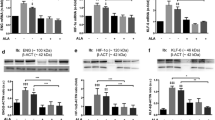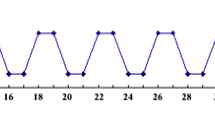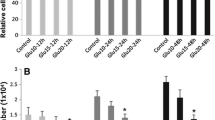Abstract
The objective of this study is to explore the mechanism of oxidative stress induced by intermittent high glucose in porcine iliac endothelial cells (PIECs). The PIECs were exposed to intermittent or constant high glucose for 3 or 6 days, and the mean fluorescent intensity (MFI) was measured via intracellular reactive oxygen species (ROS) captured by flow cytometry. The NADPH oxidase activity was measured by chemiluminescence with lucigenin. Intermittent high glucose induced a greater over-production of ROS than constant high glucose in PIECs; the NADPH oxidase activity was increased under both constant and intermittent high glucose conditions, being more marked in the latter (P < 0.05). In conclusion, intermittent high glucose induced more ROS in PIECs than constant high glucose, this effect seemed to be, at least in part related to the enhanced activation of NADPH oxidase. Glucose fluctuation may be involved in the development of vascular complications.




Similar content being viewed by others
References
The DECODE Study Group (2001) Glucose tolerance and cardiovascular mortality: comparison of fasting and 2-hour diagnostic criteria. Arch Intern Med 161(3):397–405
The DECODE Study Group (2003) Is the current definition for diabetes relevant to mortality risk from all causes and cardiovascular and noncardiovascular diseases. Diaetes Care 26(3):688–696
Watada H, Azuma K, Kawamori R (2007) Glucose fluctuation on the progression of diabetic macroangiopathy—new findings from monocyte adhesion to endothelial cells. Diabetes Res Clin Pract 77(Suppl 1):S58–S61
Otsuka A, Azuma K, Iesaki T et al (2005) Temporary hyperglycaemia provokes monocyte adhesion to endothelial cells in rat thoracic aorta. Diabetologia 48(12):2667–2674
Azuma K, Kawamori R, Toyofuku Y et al (2006) Repetitive fluctuations in blood glucose enhance monocyte adhesion to the endothelium of rat thoracic aorta. Arterioscler Thromb Vasc Biol 26(10):2275–2280
Sherwin RS (2004) Diabetes mellitus, Chap 243. In: Goldman L, Ausiello D (eds) Cecil textbook of medicine, 22nd edn. Saunders, Philadelphia, pp 1424–1452
Ceriello A (1998) The emerging role of post-prandial hyperglycaemic spikes in the pathogenesis of diabetic complications. Diabet Med 15:188–193
Muggeo M, Zoppini G, Bonora E et al (2000) Fasting plasma glucose variability predicts 10-year survival of type 2 diabetic patients: the Verona Diabetes Study. Diabetes Care 23(1):45–50
Brun E, Zoppini G, Zamboni C et al (2001) Glucose instability is associated with a high level of circulating p-selectin. Diabetes Care 24(9):1685
Rosen P, Nawroth PP, King G et al (2001) The role of oxidative stress in the onset and progression of diabetes and its complications: a summary of a congress series sponsored by UNESCO-MSBN, the American Diabetes Association and the German Diabetes Society. Diabetes Metab Res Rev 17(3):189–212
Wright E Jr, Scism-Bacon JL, Glass LC (2006) Oxidative stress in type 2 diabetes: the role of fasting and postprandial glycaemia. Int J Clin Pract 60(3):308–314
Soh N, Katayama Y, Maeda M (2001) A fluorescent probe for monitoring nitric oxide production using a novel detection concept. Analyst 126(5):564–566
Tanaka K, Miura T, Umezawa N et al (2001) Rational design of fluorescein-based fluorescence probes. Mechanism-based design of a maximum fluorescence probe for singlet oxygen. J Am Chem Soc 123(11):2530–2536
Barbacanne MA, Souchard JP, Darblade B et al (2000) Detection of superoxide anion released extracellularly by endothelial cells using cytochrome c reduction, ESR, fluorescence and lucigenin-enhanced chemiluminescence techniques. Free Radic Biol Med 29(5):388–396
Walrand S, Valeix S, Rodriguez C et al (2003) Flow cytometry study of polymorphonuclear neutrophil oxidative burst: a comparison of three fluorescent probes. Clin Chim Acta 331(1–2):103–110
Quagliaro L, Piconi L, Assaloni R et al (2003) Intermittent high glucose enhances apoptosis related to oxidative stress in human umbilical endothelial cells. Diabetes 52(11):2795–2804
Quagliaro L, Piconi L, Assaloni R et al (2005) Intermittent high glucose enhances ICAM-1, VCAM-1 and E-selectin expression in human umbilical vein endothelial cells in culture: the distinct role of protein kinase C and mitochondrial superoxide production. Atherosclerosis 183(2):259–267
Risso A, Mercuri F, Quagliaro L et al (2001) Intermittent high glucose enhances apoptosis in human umbilical vein endothelial cells in culture. Am J Physiol Endocrinol Metab 281(5):E924–E930
Griendling KK, Sorescu D, Ushio-Fukai M (2000) NAD(P)H oxidase: role in cardiovascular biology and disease. Circ Res 86(5):494–501
Griendling KK, FitzGerald GA (2003) Oxidative stress and cardiovascular injury: part I: basic mechanisms and in vivo monitoring of ROS. Circulation 108(16):1912–1916
Schleicher E, Friess U (2007) Oxidative stress, AGE and atherosclerosis. Kidney Int Suppl 106:S17–S26
Sorescu D, Szocs K, Griendling KK (2001) NAD(P)H oxidases and their relevance to atherosclerosis. Trends Cardiovasc Med 11(3–4):124–131
Dourron HM, Jacobson GM, Park JL et al (2005) Perivascular gene transfer of NADPH oxidase inhibitor suppresses angioplasty-induced neointimal proliferation of rat carotid artery. Am J Physiol Heart Circ Physiol 288(2):H946–H953
Qin-min Ge, Qing Su (2009) Effect of the NADPH oxidase inhibitor apocynin on oxidative stress induced by glucose in endothelial cells. J Shanghai Jiaotong Univ Med Sci (in press)
Acknowledgments
This study was supported by the National Natural Science Foundation of China (No.30872727). This study greatly acknowledges the support from department of cell biology, Shanghai Jiaotong University School of Medicine. The authors should also give many thanks to Professor Ji-shou Hou, Department of Endocrinology, Xinhua Hospital, Shanghai Jiaotong University School of Medicine.
Author information
Authors and Affiliations
Corresponding author
Rights and permissions
About this article
Cite this article
Ge, QM., Dong, Y., Zhang, HM. et al. Effects of intermittent high glucose on oxidative stress in endothelial cells. Acta Diabetol 47 (Suppl 1), 97–103 (2010). https://doi.org/10.1007/s00592-009-0140-5
Received:
Accepted:
Published:
Issue Date:
DOI: https://doi.org/10.1007/s00592-009-0140-5




